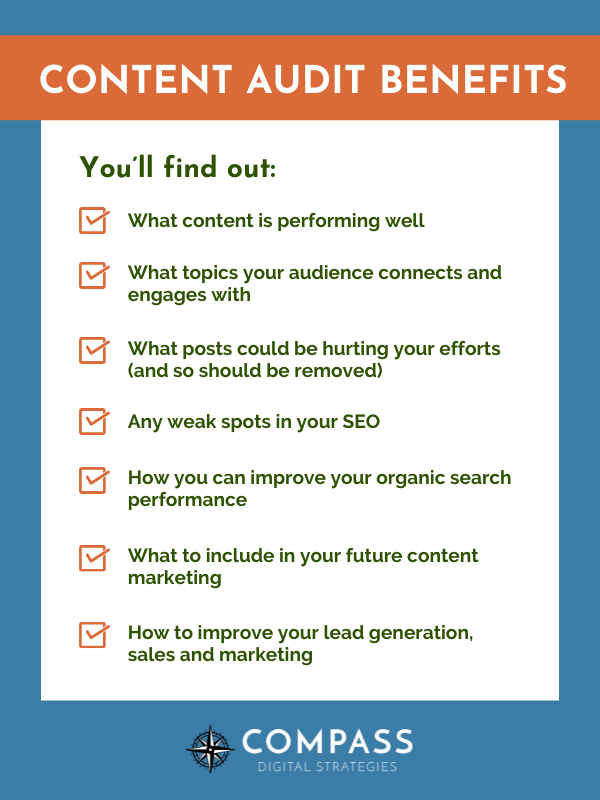The quick content auditing guide for busy small business owners
You spent a lot of time and money on your website, didn’t you?
Maybe you worked weekends to make it happen, or into the early hours of the morning. It was a hard slog. But it’s worth the effort when people who reach your website feel they must buy your product.
Except they’re not.
Unfortunately, websites can start to feel stale after a while. And when that happens, people don’t connect with it as much as they used to, and may not stick around long enough to become customers or clients.
Is that the case with your site? Let’s find out.
It’s time for a content audit.
What is a content audit?
A content audit is where you go through your site’s content and assess the relative strengths and weaknesses of each piece. You’ll then use the results to guide your future marketing. Ideally, you should do a content audit every year or so.
According to the Nielsen Norman Group (known for their global user experience leadership), a content audit examines and evaluates the quality, depth and breadth of your content.
A thorough audit will uncover:
- content that needs refreshing
- any gaps you need to fill with new content
- any content that should be removed.
You can’t do a content audit without doing a content inventory first

A content inventory is an important part of a content audit, and one you shouldn’t skip. It’s a bit like baking a cake: would you start mixing things in the bowl without knowing whether you have all the ingredients?
From the Nielsen Norman Group again: “A content inventory lists out the digital content you have and includes aspects such as each pieces’ name, format, URL, creation date, author, and metadata. A content audit determines the quality of the content and whether it needs to be updated or removed.”
A content inventory will uncover the depth and breadth of your content, but not the content’s quality or how to improve it. That’s what the audit is for. And that’s why you should always do an inventory first and then an audit.
Doing one without the other isn’t going to give you an informed marketing or SEO strategy.
The benefits of doing a content audit
A content audit will show you how successful your current marketing and SEO work has been, and help you decide what your next moves should be.
You’ll find out:
- what content is performing well
- what topics your audience connects and engages with
- what posts could be hurting your efforts (and so should be removed)
- any weak spots in your SEO
- how you can improve your organic search performance
- what to include in your future content marketing
- how to improve your lead generation, sales and marketing.

Of course, getting this information directly from your website’s performance data means you can not only refresh what needs refreshing, but also improve or better target your next efforts.
Chances are you’ve invested a lot of your own time and effort into your website content, spent a chunk of your profits getting someone else to do it, or both. Doing an annual content audit informs your marketing and SEO strategy, and reduces the risk of you wasting all that time, effort and money.
Here’s what a content audit looks like
Here’s a content audit from one of my clients.

Now unless you’ve got experience with this stuff, it probably looks quite meaningless. But there’s a lot of useful information in there, so let me explain what’s going on.
The first column is a list of all the pages on the website. We then see information about each page that I extracted using ScreamingFrog (an important SEO tool that helps me analyze the data in Google Analytics and Google Search Console).
I’ve also added an ‘Action’ column, which shows whether you need to:
- keep the page as is
- improve it with new content
- get rid of it completely.
But how do I decide what action you should take? Let’s work through that for a minute.
How do you know if your content is working?
There are a few reasons to keep your content as it is, and they’re not all related to your data. There’s always more to it than that.
Your content is getting traffic and conversions
From the data in your content audit, you’ll know whether it’s getting traffic or conversions. In other words, if people are coming to your site and taking the actions you want them to take.
Your content is picking up backlinks
You’ll also be able to see whether you’re picking up backlinks (other sites linking to content on yours). These contribute to something called a domain authority—how trustworthy search engines think your site is. The more links you have from quality sites to yours, the greater your site’s domain authority will be and the more likely it will appear in search engine results.
Your content has a more basic, structural purpose
Internal page links are interesting. If one of your pages has lots of internal links but little traffic, it’s an important internal page that you’ll need to keep on your site.
The other pages you need to keep are sometimes called ‘assets’. These include pages like contact or customer support, which are important to the overall user experience.
Your content is attracting organic traffic
The other thing to look out for is high Google Analytics (GA) entrances or users, because this is referring to organic traffic – the free, quality traffic we want.
Now, let’s see whether any of your content isn’t working for your site and needs to be removed.
How to tell if your content should be removed
If a piece of content isn’t getting any traffic or conversions then it should be removed. Keeping it can lead to ‘index bloat’, which will affect how much love you get from the search engines. And being found less in search means fewer people coming through your virtual door.
Index bloat happens when Google indexes too many ‘low-quality’ pages on your site – pages that don’t serve your visitors.
Its search engine crawlers will spend too much time on these unnecessary pages, slowing down your site and wasting your valuable crawl budget. By keeping your site clean, the search engines will index only the pages you want your visitors to find.
Every page on your site needs to serve a purpose and be valuable to your visitors.
And for that to happen, you need to remove low-quality content. Unfortunately, what constitutes low-quality content is often subjective, and so this task may not be easy.
And sometimes the data will show that a piece of content just needs a bit of tweaking to make it better.
Does your content need improving?
Your content audit will show you whether any of your content needs improving.
You may have a page that’s getting a decent amount of traffic, but low engagement and little (if any) conversions. (A high bounce rate often indicates low engagement.) This means people are finding and coming to your page but not taking the action you want them to, such as making a purchase or booking.
The fact that so many people are coming to your page is great. And you certainly don’t want to mess with that. You just need to tweak the content so they start doing what you want them to.
Take a look at the page, and think about what you can change or improve to start getting those conversions. Is the copy dull or overly wordy? Are the images putting people off? Is the layout confusing?
Knowing what to change can be tricky. But making those tweaks could be the difference between a sale and “See ya later.”
Should you consolidate your content?
Sometimes your content audit will reveal a page that’s getting little or no traffic or conversions, but has content that can really help your customers.
As a standalone page, it has poor SEO pull. But don’t delete it and lose all that useful content. Could you move the content to another page and enhance what’s already there? This is known as consolidating content, and allows you to please both your customers and the search engines.
Where to next?
Once you finish your content audit and know what’s working and what’s not, use that knowledge to guide your new content marketing strategy.
Yes, content marketing can be complex. And as a small business owner you’re already wear too many hats.
That’s why I’ve written The really big guide to content marketing strategy, which simplifies things and helps you work out where to next. There’s even a downloadable checklist to get you started.

